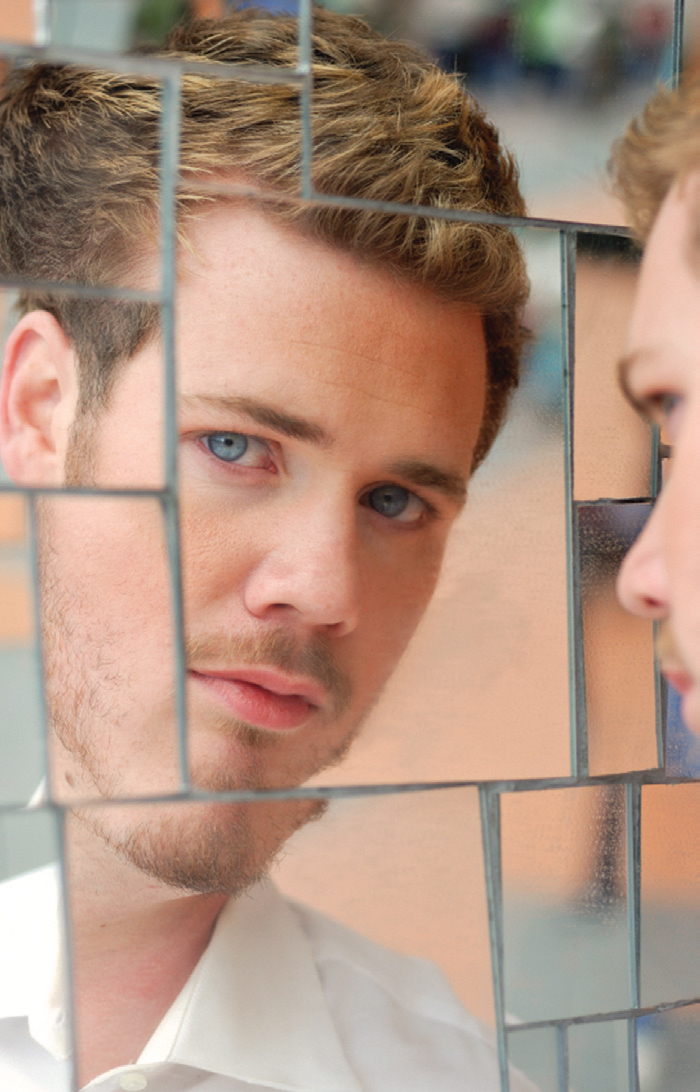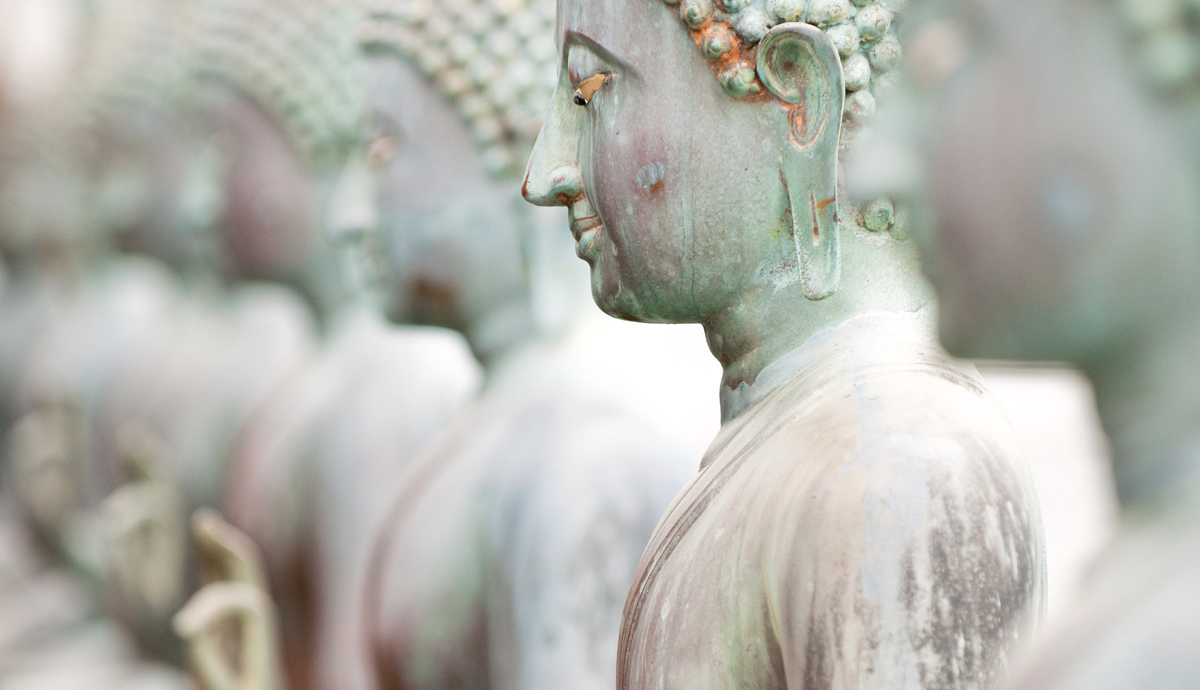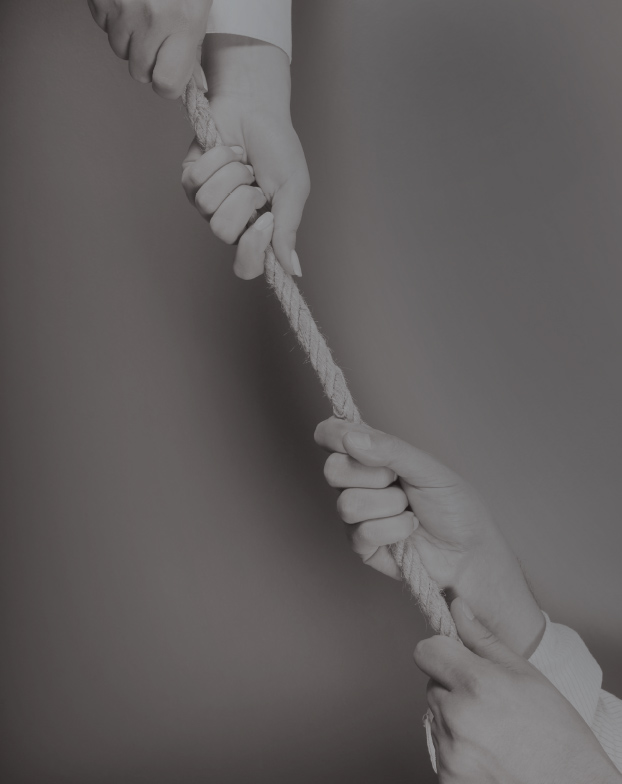“Like a ball batted back and forth,” says an ancient text called the Yoga bindu Upanishad, “a human being is batted by two forces within”: one, the upward drive to evolve into spiritual beings; the other, the fierce downward thrust of our past conditioning as separate, self-oriented, physical creatures.
The literal meaning of the Sanskrit here is “like a ball hit by a stick held in the hand.” I don’t have any idea what game the sages of ancient India had been watching, but I think tennis fits the verse perfectly.
Every one of us, this ancient text says, is being played twenty-four hours a day back and forth between two opposing inner forces. This inner tension is our evolutionary heritage. It reflects our divided nature as human beings: partly physical, essentially spiritual, constantly pulled in two conflicting directions. If this sounds bad, it is actually quite positive. For if one of these players will not let us alone, neither will the other. Built into our very nature is an inner drive that will not let us be satisfied with living at our lowest level, governed only by biological laws. Some inner evolutionary imperative is constantly exhorting us to grow, to reach for the highest that we can conceive, as if nature itself will not let us rest with anything less than spiritual fulfillment.
Sometimes when I am waiting at the dentist’s office, I like to look at the popular magazines. It doesn’t matter if they are a few months old; I am always interested in their slick advertisements. Either by innuendo or by outright declaration, they are all aimed at one deep, almost universal desire: to change who we are, make ourselves somehow better: richer, smarter, more attractive, more secure, more at home with who we are.

Unfortunately, these implicit promises of Madison Avenue deal only with externals: a fragrance that the opposite sex will find irresistible, a ring that will make a relationship “last for eternity,” a house so spectacular that we will want nothing more but to lounge in it all day and admire the appointments and the view. Despite their sophisticated appearance, below every advertisement like this I would like to write, “This won’t change you! You’ll still be the same old person. You’ll still have to live with yourself as you are.”
Toward the end of the second chapter of the Bhagavad Gita there is a statement so direct, so penetrating, that it should move us to question all external attempts at self-improvement: those who are always trying to satisfy their personal desires will never find peace in this life. Such people are doomed to live in turmoil and isolation. They may live in palatial homes, hop from one resort to another, or have their photograph on the covers of the weekly magazines, but they won’t have peace in their hearts. Why? Because if we cannot make changes where we really want to – in our own personality – it does not matter what else we may have achieved; we won’t be able to live with ourselves. We can fool all of the people some of the time and some of the people all of the time, but there is one person – our self – who will look at us with a cold eye and say, “You ain’t foolin’ me! You’re not changing yourself at all; you’re not growing.”
Often, I think, this is why active people are so active, why adventurers adventure and globetrotters trot: we do not want to stop and listen to that quiet heckler in the depths of our hearts, reminding us of our real job. This is ultimately what insecurity means; that is where a sense of inadequacy really comes from.
During the past twenty-five years, I must have heard the same refrain from hundreds of people, particularly those who are young: “I just don’t like myself.” The unspoken assumption is, “This is the kind of person I am, and it’s what I always will be. If I have crippling fears, the best I can do is learn to live with them. If I am prone to fits of anger, people will just have to accept me as I am.”
But we can change. No one need ever feel resigned and say, “There is nothing I can do.” There is everything we can do. That is the purpose and the power of that persistent upward force within us: if we turn inward we can remake ourselves completely, modeling ourselves in the image of the loftiest spiritual ideal we can conceive.
There are changes any one of us can learn to make. If you can be secure where you were insecure, selfless where you were selfish, if you can respect people around you even if they don’t like you and you don’t like them, then I will say with joy, “Yes. You really have changed.” As Meister Eckhart would say, “The pauper that you were is dead; the prince is born.”
This rebirth is the purpose of meditation. It is a tremendous adventure, the greatest that can beckon to a human being. It tests every quality we possess, brings into play every faculty we have. It is for embarking on this supreme adventure that we have come into the world, and until we accept the challenge, we can never really rest content with anything less.
One of the greatest spiritual figures of medieval India, Ramanuja, throws light on this challenge in words that should be on the walls of every school campus, every statesman’s office, every home: “What we seek as our highest goal depends upon what we believe ourselves to be.”
If you reflect on this brief statement, you can get lost in its manifold ramifications. Virtually all of us believe we are physical creatures, subject to biological laws. And when you believe you are a physical creature, Ramanuja says, the highest goal you can aim at has to have physical limits. You will spend your life seeking physical satisfactions. A full diagnosis of human suffering is given in just this one line.
Like everybody else, I grew up believing that I was purely physical, a collection of biochemical constituents. My friends subscribed to this belief; my learned colleagues shared it vehemently. The world we live in is based on this view; everyone takes it for granted. Even if we believe intellectually that the human being has a spiritual side, very, very few of us can conceive of ourselves without the physical, biochemical apparatus of our body and personality.

What has changed for me since then? Everything. Not two or three things but everything. Through meditation, with the help of the demanding disciplines I followed every day in the midst of a busy life, that belief in myself as a purely physical creature has fallen away completely. Today I do not look upon myself or anyone else as physical. I identify with the Self, pure spirit, the same in all.
In this realization, the body becomes no more than a kind of jacket that you wear: you take care of it as very useful, but you never once think that it and you are the same.
Imagine if you thought you were your jacket. Taking it to the cleaners would be frightful; torn pockets would be a major trauma. It sounds silly, but that is just how most of us relate to our bodies too. To a surprising extent, we live to please our body instead of having it help and serve us. We identify with it so closely that we allow it to make decisions for us and dictate how we feel about ourselves. When our body experiences a craving, we say it’s a “biological necessity.” If our appearance is less than perfect, we think there is something wrong with us.
It is from this obsessive identification with the body, I believe, that many physical and emotional problems arise. In meditation, as we learn at deeper and deeper levels that the basis of our personality is not physical but spiritual, such problems fall away. Often we do not even have to confront them. We simply go deeper, move away from the tenements of consciousness where they arise. You can leave psychosomatic problems hanging in the closet and find another home in a much safer neighborhood; they will never be the wiser. This approach is very different from the conventional wisdom of the modern world. It cannot work without meditation. For it is much more than a change in lifestyle; it is a transformation of thought-style.
As we absorb this higher image of who we are, many important consequences follow. When you know that you are essentially spiritual, you no longer relate to yourself as a creature to be satisfied with physical pleasures. You do not relate to others in terms of their physical appearance. You know that your worth derives from the eternal Self within you – and because this same Self lives in the hearts of all, you find it easy to relate to everyone with respect and love.

This change in personal relationships is one of the most joyful benefits of spiritual experience, yet it brings enormous responsibilities. When we see ourselves in all, detachment from our own ego is essential. Otherwise we will get emotionally entangled in other people’s problems, which is just the opposite of love.
Much of my day, for example, is spent in guiding others in meditation, both by letter and in person. Often these friends bring with them burdensome personal problems. If I identified myself with my body and mind instead of with the Self, I would not be able to bear such burdens cheerfully day after day without ever feeling burned out. I would come to the dinner table and spend half an hour staring down at my plate, thinking, “What can I do to help this person out?” When we believe we are the mind, no matter what we are doing, part of the mind cannot help chewing the same problems over and over. During meditation our concentration is scattered; during the day our vitality is drained, our security is low, and our capacity to relate to people is cramped and constrained. Everything is affected.
Today, just because of this change of belief, I do not have any demands on my vitality that I cannot meet. I can face hard blows with equanimity, help others to solve the most prickly of problems with compassion and not get involved in the turmoil. And when an emergency comes up, I can write a huge check against my vitality account and know that it will not bounce. There is no magic about this; anyone can learn to do it. Such benefits give plenty of motivation to work hard at changing our image of who we are – from a separate, physical creature into a whole, loving, spiritual being.

The cry of freedom has always appealed to me deeply. Even in my youngest days, Granny could always get me to change direction with just one question: “Don’t you want to be free?” So today, if someone is allergic to phrases like “spiritual living,” I say, “All right. Let’s talk about living in freedom.” Until we stop letting ourselves get knocked about by our biological conditioning, we don’t have any idea what freedom really means.
Remember the Buddha’s words: “All that we are is the result of what we have thought.” If our thinking is based on stimulus and response, he is trying to tell us, then most of us live like puppets, moved by patterns of thinking built up over years of repetition. These habits of mind cause us to say and do certain things habitually. They motivate our actions and mouth our words, and we just go along.
When we lose our temper, for example, it is as if anger were a puppet master, sticking two fingers up into our head and stimulating all the old control centers to make us move. “Start fussing and fuming now! You know how. Remember?” When we act on these angry impulses, we are adding to our habitual angry response. After a time, we have precious little choice in how we respond to the frustrations and irritations of everyday life. Someone gets in our way and we can’t help exploding. It is not as if we choose to get angry. Anger – what yoga psychology calls the anger samskara – is making our decisions for us.
The same mechanism is at work in all our rigid, conditioned emotional reactions – resentment, jealousy, lust, anxiety, greed, self-will, and their hundred and one relations. We would be amazed if we could look below the surface level of consciousness and see how many of our problems are caused by these deep-seated habits of thinking. This is a distressing sight, but it serves a vital purpose: it fires the desire to rise once and for all above the tyranny of our mind.
How can we do this? Is it possible not to be batted back and forth between spiritual and physical demands?
Yes, the mystics answer with one voice, it is possible. We can learn to make every response a matter of free choice. If we can ally all our personal efforts with the upward drive of evolution, it will carry us beyond the reach of physical conditioning to a state where love, resourcefulness, and vitality are spontaneous and free.
“In the river of life,” says another ancient yoga text, “two currents flow in opposite directions. One, on the surface, flows toward sorrow, toward sickness, toward bondage. The other, beneath it, flows toward happiness, health, and freedom.” This may be fantastic hydrodynamics, but it illustrates our predicament perfectly. If we stay at the surface and do nothing, this image suggests, life will still take us somewhere – but not where we want to go. Staying in one place is not an option. To catch the deep current that leads to freedom, we have to swim and swim hard, against the flow of every conditioned response.
Again, the Buddha’s words give us the key: “All that we are is the result of what we have thought.” How does the mind become conditioned? By thinking the same thoughts over and over and over. To get free, then, we have only to think opposite thoughts over and over. That is why the Buddha called his way of life patisotagami: swimming “against the current” of selfish living, in order to merge at last in the flow of love that is our real nature.
This is not just for the thrill of mastery. The Buddha is not the kind of teacher to tell us to do something contrary simply because it is hard, or to do something painful simply because we learn from pain. Going against the current has a very down-to-earth purpose: the reconditioning of the nervous system, so that we can rise above the dictates of pleasure and pain.
In all of us, the nervous system is conditioned to strict one-way traffic: toward what we like and away from what we do not like. Any attempt to drive against this traffic brings a cry of protest from body and mind. This reaction is only natural; it is part of our biological inheritance. But pleasure and pain are part of life. Often we find it necessary to do something unpleasant or forgo something pleasant for the sake of a higher goal. At such times we need the full cooperation of our body and mind, a nervous system that can face life’s challenges without complaint. This is not merely spiritual living. It is the essence of a stress-proof personality, which everyone in the modern world needs.
“Yoga,” says the Bhagavad Gita, “is evenness of mind.” When you can keep your mind on an even keel in good fortune and bad, in pleasure and pain, when you can be kind to those who like you and to those who do not, then you have reached the state of yoga: you are free.
Between senses and sense objects, the Gita explains – for example, between the taste buds and a fresh pizza – there is an intimate affinity which has nothing to do with us. Our dog has a similar affinity with buttered toast. The moment he senses a piece he has to have it, even if he has already eaten. And then he can’t just gobble it down. He has to go over to a particular spot, next to a particular yellow dandelion, and fold his paws around his toast in a particularly dainty way; only then can he eat. That is just what the senses do with sense objects, the Gita suggests, and there is no need for us to jump in. I enjoy watching my dog enjoy his toast, but I don’t get emotionally involved. If there is no toast for me, I don’t get depressed or feel deprived. His job is to eat; mine is to watch and enjoy.
Similarly, the Gita says, although sensory events have a compelling effect on the body and the mind, they really have nothing to do with us. We think we are involved because we identify ourselves with the body. Our real Self, pure spirit, is the detached observer, who watches life with quiet compassion, always free to enjoy.
In the Bhagavad Gita, the Lord quietly tells his disciple Arjuna: “When the senses encounter sense-objects, a person experiences cold or heat, pleasure or pain. These sensations are fleeting; they come and go. Bear them patiently, Arjuna.”
This is profound, practical philosophy, with a touch of humor in it too. “Arjuna,” Lord Krishna asks teasingly, “When you have your bath, do you cry if the water is warmer than you like? Do you get angry if it is a little too cold?” Temperature is just the contact of water with skin, sometimes pleasant, sometimes unpleasant. On a cold morning it is enjoyable to have a hot shower; after a hot day, it is refreshing to plunge into a cool river. Everybody finds these experiences pleasant. But we don’t spend a lot of time thinking about them. We don’t go around telling everyone in the office, “I had a hot shower this morning!” or go to bed depressed because the bathwater was too cold. It is the same with the mind. Just as we experience a momentary sensation of warmth or cold on the skin, we feel a momentary sensation of liking or disliking in the mind, as fleeting and insubstantial as a shadow.
Our usual response, however, is to cling to things we like as if they could last forever – and without realizing it, we cling to things we dislike too. When someone says something objectionable we comment to ourselves, “I don’t like that person.” And we keep on saying it, despite all the other things he or she may say or do; we can’t let go. “This is just a momentary touch of unpleasantness,” Sri Krishna would say. “Why get excited over it? Don’t give it any more attention than you would a tepid bath.”
Of course, this is quite difficult to do. But even more difficult is to look on pleasure in the same way. Sri Krishna’s advice here is thoroughly original. When he says, “Put up with pain,” Arjuna nods; he is a warrior and can understand that. But when Krishna adds, “Put up with pleasure too,” Arjuna rubs his ears. “That’s right,” Krishna says, “Bear it patiently. It comes and goes. Don’t run after it, and don’t try to cling to it when it comes your way.” Pleasure is as fleeting as suffering. In fact, as the Buddha says, most of our suffering comes from trying to cling to pleasure, trying to build happiness on a sensation that comes and goes.

The artistry of this appeals to me deeply. Today, after a lifetime of taking Sri Krishna’s words to heart, if you see me in a pleasant situation and ask, “How are you doing?” I will say, “I’m bearing up.” I am enjoying myself, but I am patiently keeping my mind unruffled too – in fact, it is only a calm mind that can really enjoy. Then, when something unpleasant comes – as it is sure to – I can say, “I’m bearing this well also.” If it does not sound paradoxical, I enjoy life when fortune is against me just as I do when fortune shines.
Eknath Easwaran (1910-1999) is respected around the world as the originator of passage meditation and an authentic guide to timeless wisdom. An Indian professor of English literature and a writer and speaker, he came to the U.S. in 1959 and founded the Blue Mountain Center of Meditation in 1961. The centre carries on his work today through publications and retreats. bmcm.org
Reprinted with permission from Conquest of Mind: Take Charge of Your Thoughts & Reshape Your Life Through Meditation by Eknath Easwaran (Nilgiri Press, 2010). © 2010, The Blue Mountain Center of Meditation, CA.







